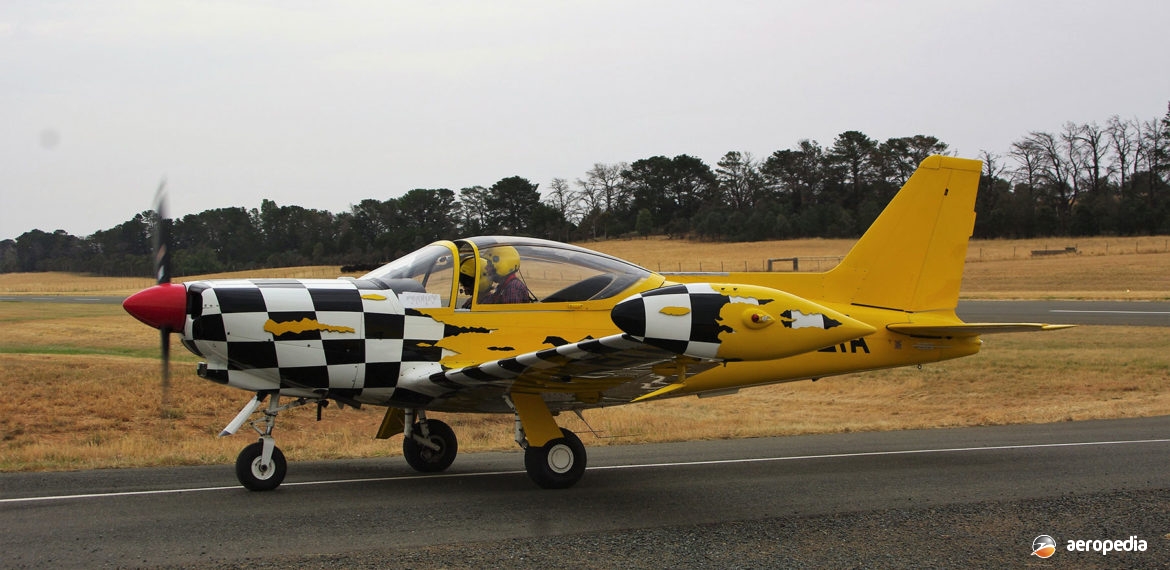Photograph:
Siai Marchetti SF.260 VH-SIA (c/n 113) at Bowylie, NSW in November 2009 (David C Eyre)
Country of origin:
Italy
Description:
Four-seat cabin monoplane
Power Plant:
One 194 kw (260 hp) Lycoming O-540-E4A5 six-cylinder horizontally-opposed air-cooled engine
Specifications:
- Wingspan: 8.22 m (26 ft 11¾ in)
- Length: 7.01 m (23 ft)
- Height: 2.6 m (8 ft 6 in)
- Wing area: 10.08 m² (108.5 sq ft)
- Max speed at sea level: 370 km/h (230 mph)
- Cruising speed at 75% power at 1,951 m (6,500 ft): 357 km/h (222 mph)
- Cruising speed at 65% power at 3,048 m (10,000 ft): 346 km/h (215 mph)
- Initial rate of climb: 549 m/min (1,800 ft/min)
- Service ceiling: 6,514 m (21,370 ft)
- Range: 1,690 km (1,050 miles)
- Empty weight: 675 kg (1,488 lb)
- Loaded weight [aerobatic]: 998 kg (2,200 lb)
- Loaded weight [utility]: 1,100 kg (2,425 lb)
History:
Designed by Stelio Frati, and built by a company known as Aviamilano in Italy, the prototype of this high-performance cabin monoplane was flown for the first time on 15 July 1964. Known as the F.250, and powered by a 186 kw (250 hp) Lycoming O-540-A1D engine, it was Stelio Frati’s first all-metal design and was basically a more powerful and fully aerobatic development of the Falco. A licence to build the aircraft was obtained by Siai Marchetti and the second prototype, known as the SF.260, was built by that Company. With an up-rated engine, it first appeared in 1966.
Fully aerobatic with two persons on board, the type was adopted by the airlines Air France and Sabena as a trainer at pilot schools. It was also developed as a counter-insurgency aircraft with armament under the wings, and sold to a number of air forces. In the United States the SF.260 was marketed as the Waco TS-250-3 Meteor, with the old very well respected ‘Waco’ name being resurrected to assist in the sale of the aircraft in that region.
The SF.260 was a high-performance aircraft, and at one time held two world records for its class, ratified by the FAI, these being: 322.52 km/h (200.41 mph) over a 1,000 km (621.4 miles) closed circuit on 25 March 1959; and 369.43 km/h (229.56 mph) over a 100 km (62.14 miles) closed circuit. In 1974 the SF.260B appeared, this model embodying further detail refinements including a 24 volt electrical system to replace the 12 volt system, aileron servo tabs, and an increase in the wingspan.
The SF.260C followed and remained in production until the SF.260D appeared. This had some minor changes, one of which allowed the +7/-3g aerobatic weight to be increased to 1,102 kg (2,430 lb); and a fuel injected IO-540-D or AEIO-540-D engine with an inverted fuel and lubrication system to be installed. The SF.260E appeared in 1992, this being developed to contest the USAF Elementary Flight Screener competition; and the SF.260F shortly after. Examples were supplied to air forces including Zimbabwe, the Philippines, Turkey, Colombia, Dubai, Ethiopia, Haiti, Ghana etc.
A small number of SF.260s have been registered in this region. VH-SFN (c/n 122) was an English entrant (G-AXKA) in the December 1969 London – Sydney Air Race. This machine, which had previously carried a Belgian registration (OO-HEI), was subsequently sold in Australia and registered in January 1972. It was reported as sold overseas in 1973 but is believed not to have been exported and to have been broken up.
A second aircraft, VH-ARV (c/n 108), was first registered in December 1977 but was substantially damaged at Branxholme, VIC on 12 March 1978. It was repaired and for a period carried the words ”The Greater Pacific Aeroplane Company” on the fuselage side. It later became VH-OTI and was operated with AirAg Aviation Services of Bankstown, NSW.
A couple have been operated by the Sydney Aerobatic School at Bankstown. A third example was imported in 2006, becoming VH-SIA² (c/n 113 – ex N260PP, N1375P, ZS-EYW) on 27 July.
One SF.260C has been registered in New Zealand. This aircraft became ZK-RHL (c/n 729/49-007 – ex N72FD), having been flown from Brisbane, QLD to Wellington on 8 January 1986. Late in June 1986 it became ZK-MUR and was painted in a camouflage scheme. It was later sold in the USA and left Auckland on 29 August 1988. However, it was lost when it made a forced landing on a beach near Qassiarsuk in Greenland on 18 October 1988.
Variants of the type available in later years included the SF.260M two/three-seat military trainer; SF.260W Warrior trainer and tactical support model; and SF.260TP which was fitted with a 261 kw (350 shp) Allison 250-B-17C turboprop and was aimed at the military market.

